
Annuity Purchase Update: April 2020 Interest Rates
April 2020 | |||||
Duration: | 7 Years | 15 Years | 7 Years | 15 Years | |
Range Rate: | 1.25% – 2.41% | 1.92% – 2.90% | Average Rate: | 1.95% | 2.49% |
As mentioned in our March 2020 Pension Finance Update, pension plans lost ground last month. COVID-19 has had a profound impact on the world, and as a result of the pandemic, the markets have proven extremely volatile this past month. The strong equity market returns of 2019 were set back by poor performance in the first quarter of 2020. The average duration 7 annuity purchase interest rates increased by roughly 30 basis points and average duration 15 rates increased by over 60 basis points since last month. This increase in rates led to a corresponding decrease in annuity purchase prices of approximately 2.1% for Annuity Plan 1 and 9.6% for Annuity Plan 2.
Pension plans experienced much more volatility in the month of March than any other month in recent history. While market volatility has caused the treasury rates to fall dramatically, the spread between treasury bonds and the bonds insurance companies invest in have widened. The widening of this spread would typically tell us that now would be a good time for pension plans to purchase annuities. Furthermore, we’ve observed aggressive pricing from the insurance companies in 2020. In March we conducted annuity purchases where the retiree premium matched GAAP liabilities.
The aggressive pricing may also be due to a decrease in market activity relative to 2019 from the impact of COVID-19. While the PRT market in 2020 has been active, insurance companies have shown that there is additional capacity. Recent news has suggested that the impacts of COVID-19 will continue at least until the end of summer. With that news in mind, we find it unlikely interest rates will rise in the coming months. If interest rates do rise this year, the PRT market may become flooded with activity and insurers may be less inclined to price aggressively. For plan sponsors wishing to settle liabilities in 2020, we believe marketing your liability to the PRT market as soon as possible to be a prudent measure.
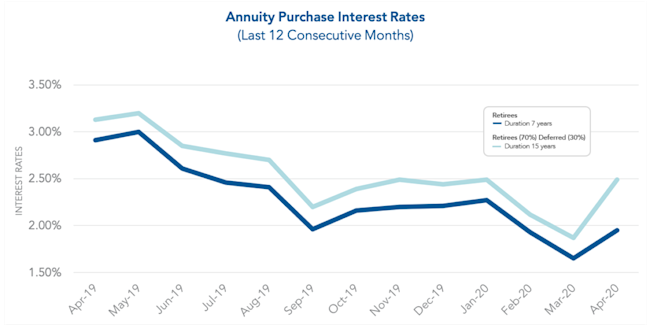
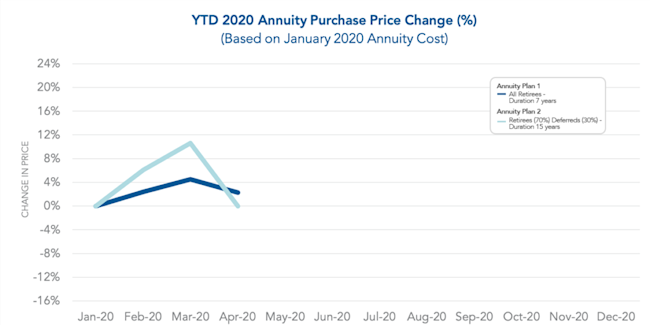
History demonstrates annuity purchase interest rates fluctuate over time with varying degrees of peaks and valleys. We observed an upward trend in both duration 7 and duration 15 annuity purchase rates at the end of 2019. However, due to the COVID-19 pandemic, annuity purchase rates dropped in February and March 2020, and have now risen to rates consistent with January 2020. Plan sponsors should consider getting their data in order for a Pension Risk Transfer. Implementing a Pension Risk Transfer strategy can help a plan sponsor fulfill organizational goals, including reducing volatility in financial disclosures due to volatile interest rates.
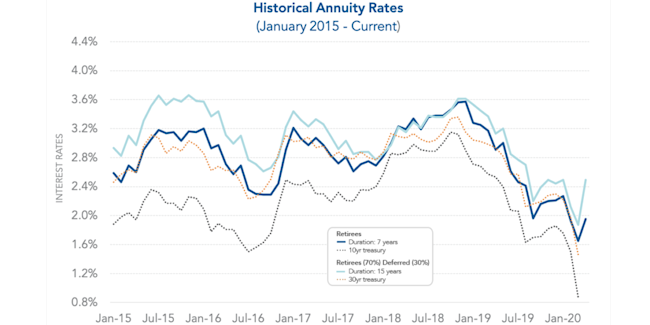
The spread of annuity purchase prices above the GAAP projected benefit obligation (PBO) remained fairly stable during 2019. This spread was around 3% for Annuity Plan 1 and 11% for Annuity Plan 2. In January 2020, the spread increased in part due to adoption of the new Pri-2012 mortality tables and MP-2019 mortality improvement scales, which generally lowered GAAP liabilities. In February and March 2020, the spread increased further as a result of the significant drop in annuity purchase interest rates and yield curve interest rates.
In April 2020, the spread for Annuity Plan 2 dropped to nearly 8.5% and although the spread for Annuity Plan 1 increased, it remained fairly stable. Relative to GAAP, we have seen that an increase in annuity purchase rates generally lowers annuity purchase prices. Keep in mind that the below PBO calculations exclude future overhead costs paid by plan sponsors to retain participants in the plan. Administrative expenses and PBGC premiums are examples of these overhead costs. Future overhead costs would narrow the spread, though the extent is plan specific.
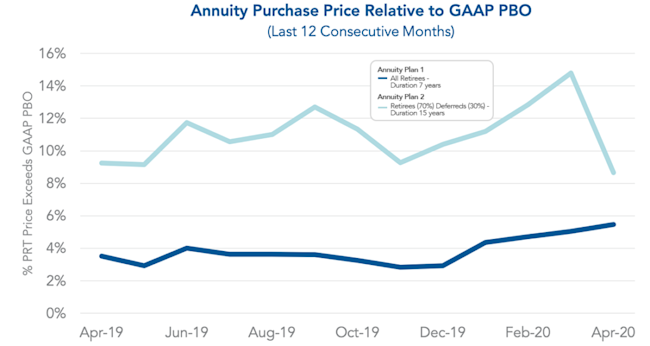
This past year, a significant month-to-month cost volatility has persisted. Timing an early entrance to the insurance market is a crucial part of the planning stage because of the consistent short-term volatility of annuity pricing. Sponsors can take advantage of favorable fluctuations in a volatile market by connecting with an annuity search firm early.
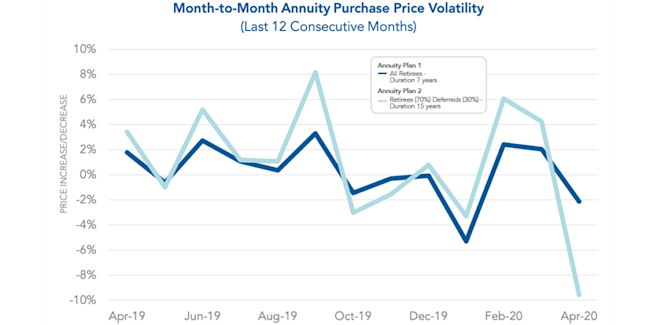
During these volatile times, one strategy plan sponsors have engaged in is borrowing to fund their pension plan. The recent activities in the markets will negatively effect the funding status of all plans and therefore may increase your plans PBGC Variable Rate Premium. In 2020, the PBGC Flat-Rate Premium will increase to $83 per participant, the Variable-Rate Premium will increase to 4.5% of unfunded vested benefits, and the Variable-Rate Premium Cap will increase to $561 per participant. As part of managing a pension plan, plan sponsors should consider a borrow-to-fund solution for de-risking their plan. By borrowing to fund, plan sponsors can exchange volatile pension liabilities in return for a fixed low interest rate loan. The benefits this funding can have include reducing PBGC premiums and accelerating tax deductions, as well as allowing plan sponsors to focus more on their core business. Additional detail regarding the potential merits of a borrow-to-fund strategy can be found here.
Looking ahead to future plan years, per our March Pension Finance Update, PPA funding relief will gradually sunset and this will generally lead to increased contributions from plan sponsors. Plan sponsors may wish to use these contributions to reduce the plan’s overall liability through use of a Pension Risk Transfer.
In 2020, the PBGC Flat-Rate Premium, Variable-Rate Premium, and Variable-Rate Premium Cap have each increased. Per our 2019 PBGC Premium Burden Report, PBGC premiums remain a major threat to pensions, and continued attention to premiums should be a central part of viable pension management for the foreseeable future. Through use of a Pension Risk Transfer, plan sponsors can eliminate or significantly reduce future PBGC premiums.
In October 2019, the Society of Actuaries published (1) a new Mortality Improvement Scale MP-2019 and (2) new base Pri-2012 Mortality Tables. Both the MP-2019 and Pri-2012 will generally reduce defined benefit plan liability valuations marginally.
Have a pension risk transfer need but not sure where to start? See our article, What to Look for in an Annuity Search Firm.
*October Three collects annuity purchase rates for Duration 7 years and Duration 15 years from several insurers on a monthly basis. We have constructed 2 hypothetical annuity plans which have been valued using the latest mortality tables. Annuity Plan 1 contains retirees only and has a liability duration of 7 years. Annuity Plan 2 contains 70% retirees and 30% deferreds and has a liability duration of 15 years. Using the collected annuity purchase rates and 2 hypothetical annuity plans, we have produced the following graphs representative of actual 2019 and 2020 Pension Risk Transfer market activity and the corresponding impact on pension plans.
